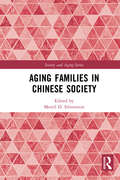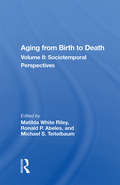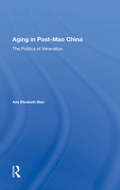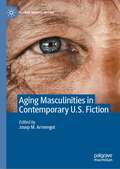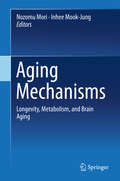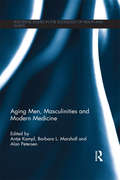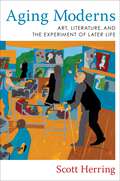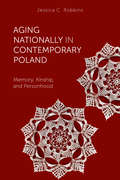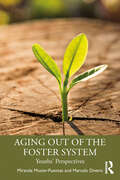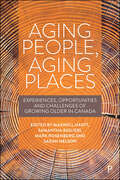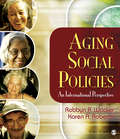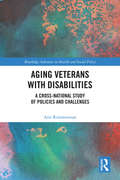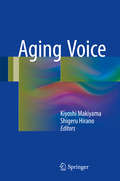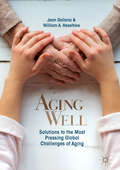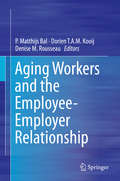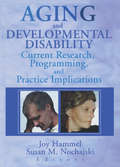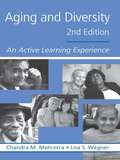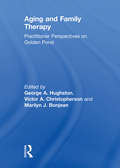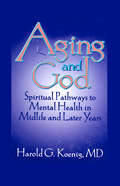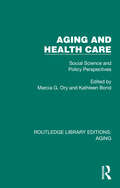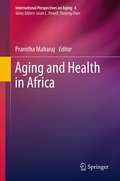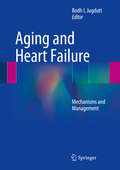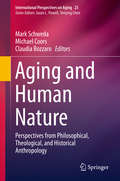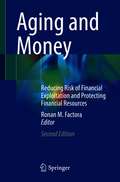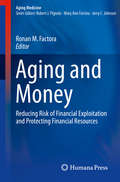- Table View
- List View
Aging Families in Chinese Society (Society and Aging Series)
by Merril D. SilversteinDeclining fertility rates and increased life expectancies over the last few decades have conspired to make China one of the more rapidly aging societies in the world. Aging Families in Chinese Society focuses on the accelerated social and demographic changes in China and examines their implications for family care and support for older adults. Contributors to this landmark volume portray various challenges facing aging families in China as a result of reduced family size, changing gender expectations, rapid economic development and urbanization, rural-to-urban migration, and an emerging but still underdeveloped long-term care system. Divided into four thematic areas – Disability and Family Support; Family Relationships and Mental Health; Filial Piety and Gender Norms; and Long-term Care Preferences – chapters in this volume confront these burgeoning issues and offer salient policy and practice considerations not just for today’s aging population, but future generations to come. Combining quantitative data from social surveys in China, comparative surveys in Taiwan and Thailand, and qualitative data from in-depth interviews, Aging Families in Chinese Societies will be of significant interest to students and researchers in aging and gerontology, China and East Asian Studies and population studies.
Aging From Birth To Death: Volume 2, Sociotemporal Perspectives
by Michael S. Teitelbaum Ronald P. Abeles Matilda White RileyThis book provides deeper understanding of the aging process, of the likely differences between the lives of past and future generations, and of the potential for optimizing these future lives from cross-cultural and cross-temporal perspectives.
Aging In Post-mao China: The Politics Of Veneration
by Ada Elizabeth SherThis case study of Shenyang, the industrial capital of Liaoning Province, explores what it means to be old in the People's Republic of China, especially in terms of religious and ethical traditions, education, health, and current political, economic, and employment trends. .
Aging Masculinities in Contemporary U.S. Fiction (Global Masculinities)
by Josep M. ArmengolThis book focuses on representations of aging masculinities in contemporary U.S. fiction, including shifting perceptions of physical and sexual prowess, depression, and loss, but also greater wisdom and confidence, legacy, as well as new affective patterns. The collection also incorporates factors such as race, sexuality and religion. The volume includes studies, amongst others, on Philip Roth, Paul Auster, Toni Morrison, Ernest Gaines, and Edmund White. Ultimately, this study proves that men’s aging experiences as described in contemporary U.S. literature and culture are as complex and varied as those of their female counterparts.
Aging Mechanisms: Longevity, Metabolism, and Brain Aging
by Nozomu Mori Inhee Mook-JungThis book brings together the most up-to-date information on recent research results of leading laboratories on aging science in East Asia, particularly in Japan, Korea, and Hong Kong. Starting with a comprehensive overview of various hypotheses on biological mechanisms of aging by Dr. Sataro Goto, each chapter covers broad aspects of the most recent findings in aging-related topics: centenarian studies and genome analysis of progeria, metabolic biochemistry and neurobiology, longevity controls in yeast and nematodes, oxidative stress and calorie restriction, and neurodegeneration mechanisms in Alzheimer's and Huntington's diseases, with further potential therapeutic approaches to these age-related neurodegenerative diseases. Also included, in part, is a summary and the outcomes of a scientific discussion forum called the Asian Aging Core for Longevity (AACL) that has been held annually alternating between Japan and Korea during the last decade. This book can serve as a useful resource for finding appropriate collaborators in the areas it covers. The target readership is made up of graduate students and researchers at universities, medical and/or life-science schools, and biomedical and pharmaceutical institutes. Why does aging exist? How do we age? How is each organism's lifespan determined? These are fundamental questions in the field. We may be still far from achieving a complete view of aging mechanisms, but this book, Aging Mechanisms, offers an excellent opportunity to become familiar with the most updated progress in the biomedical research of aging in Japan and Korea, the two leading nations for human longevity.
Aging Men, Masculinities and Modern Medicine
by Alan Petersen Antje Kampf Barbara L. MarshallAging Men, Masculinities and Modern Medicine explores the multiple socio-historical contexts surrounding men’s aging bodies in modern medicine from a global perspective. The first of its kind, it investigates the interrelated aspects of aging, masculinities and biomedicine, allowing for a timely reconsideration of the conceptualisation of aging men within the recent explosion of social science studies on men’s health and biotechnologies including anti-aging perspectives. This book discusses both healthy and diseased states of aging men in medical practices, bringing together theoretical and empirical conceptualisations. Divided into four parts it covers: Historical epistemology of aging, bodies and masculinity and the way in which the social sciences have theorised the aging body and gender. Material practices and processes by which biotechnology, medical assemblages and men’s aging bodies relate to concepts of health and illness. Aging experience and its impact upon male sexuality and identity. The importance of men’s roles and identities in care-giving situations and medical practices. Highlighting how aging men’s bodies serve as trajectories for understanding wider issues of masculinity, and the way in which men’s social status and men’s roles are made in medical cultures, this innovative volume offers a multidisciplinary dialogue between sociology of health and illness, anthropology of the body and gender studies.
Aging Moderns: Art, Literature, and the Experiment of Later Life
by Scott HerringWhat happens when the avant-garde grows old? Examining a group of writers and artists who continued the modernist experiment into later life, Scott Herring reveals how their radical artistic principles set out a new path for creative aging.Aging Moderns provides portraits of writers and artists who sought out or employed unconventional methods and collaborations up until the early twenty-first century. Herring finds Djuna Barnes performing the principles of high modernism not only in poetry but also in pharmacy orders and grocery lists. In mystery novels featuring Gertrude Stein and Alice B. Toklas along with modernist souvenir collections, the gay writer Samuel Steward elaborated a queer theory of aging and challenged gay male ageism. The Harlem Renaissance dancer Mabel Hampton dispelled stereotypes about aging through her queer of color performances at the Lesbian Herstory Archives. Herring explores Ivan Albright’s magic realist portraits of elders, Tillie Olsen’s writings on the aging female worker, and the surrealistic works made by Charles Henri Ford and his caregiver Indra Bahadur Tamang at the Dakota apartment building in New York City.Showcasing previously unpublished experimental art and writing, this deeply interdisciplinary book unites new modernist studies, American studies, disability studies, and critical age studies. Aging Moderns rethinks assumptions about literary creativity, the depiction of old age, and the boundaries of modernism.
Aging Nationally in Contemporary Poland: Memory, Kinship, and Personhood (Global Perspectives on Aging)
by Jessica C. RobbinsActive aging programs that encourage older adults to practice health-promoting behaviors are proliferating worldwide. In Poland, the meanings and ideals of these programs have become caught up in the sociocultural and political-economic changes that have occurred during the lifetimes of the oldest generations—most visibly, the transition from socialism to capitalism. Yet practices of active aging resonate with older forms of activity in late life in ways that exceed these narratives of progress. Moreover, some older Poles come to live valued, meaningful lives in old age despite threats to respect and dignity posed by illness and debility. Through intimate portrayals of a wide range of experiences of aging in Poland, Jessica C. Robbins shows that everyday practices of remembering and relatedness shape how older Poles come to be seen by themselves and by others as living worthy, valued lives. In Aging Nationally in Contemporary Poland, we see how memories and understandings of the Polish nation intersect with ideals and experiences of late life to produce forms of life that are not reducible to binary categories of health or illness, independence or dependence, or socialism or capitalism.
Aging Out of the Foster System: Youths' Perspectives
by Marcelo Diversi Miranda Mosier-PuentesDecades of demographic studies and applied efforts have convinced scholars, students, and social workers that young people coming of age and transitioning out of the foster care system face great challenges in health, education, income, and general well-being. Despite the wealth of research on these outcomes, we know much less about the lived experiences of young people leaving foster care.Aging Out of the Foster System: Youths' Perspectives adds to this narrative the personal experiences of young people who are aging out or have aged out of their child welfare placement. The authors center the stories of these young people and apply critical ethnographic methods to frame their accounts with attention to the encounters within which they were produced, including power imbalances, institutional contexts, and relational dynamics.By centering the experiences of youths in these contexts and attending to the larger forces at work, this book helps connect the dots between youth aging out of the foster care system, social workers in Independent Living Programs, and the professors and scholars teaching the next generations of professionals working to support the aging out process.
Aging People, Aging Places: Experiences, Opportunities, and Challenges of Growing Older in Canada
by Maxwell Hartt, Samantha Biglieri, Mark W. Rosenberg & Sarah E. NelsonHow well do the places where we live support the wellbeing of older adults? The Canadian population is growing older and is reshaping the nation’s economic, social and cultural future. However, the built and social environments of many communities, neighbourhoods and cities have not been designed to help Canadians age well. Bringing together academic research, practitioner reflections and personal narratives from older adults across Canada, this cutting-edge text provides a rare spotlight on the local implications of aging in Canadian cities and communities. It explores employment, housing, transportation, cultural safety, health, planning and more, to provide a wide-ranging and comprehensive discussion of how to build supportive communities for Canadians of all ages.
Aging Social Policies: An International Perspective
by Professor Robbyn R. Wacker Dr Karen A. RobertoDue to population explosion and a global increase in average life expectancies, an unprecedentedly high percentage of the world's population is aging. By the middle of this century there will be up to 2 billion individuals over the age of 65, a demographic shift never before experienced in our human history. In addition, declining birth rates in industrialized countries means a decrease in the number of adults under 64. In Aging Social Policies: An International Perspective the authors consider how policy – domestic and international – affects and will continue to affect the lives of our aging population.
Aging Veterans with Disabilities: A Cross-National Study of Policies and Challenges
by Arie RimmermanThe number of older war veterans receiving disability benefits is steadily growing and is predicted to rise in the next decade. This book provides comprehensive knowledge about health and psychosocial concerns of veterans aging with disabilities and unmet needs and compares policy in three countries that have been involved in massive warfare in the 20th century––the United Kingdom (UK), the United States (US), and Israel. Using a cross-national comparative study of the policies, legislation and services provided by these three countries, which have significant numbers of aging disabled military veterans, this book provides evidence-based knowledge on the trajectories and attendant mental-health and psychosocial problems this sub-group faces when aging with a disability. It sheds light on the paradox in which most veterans with disabilities in the UK, USA and Israel are older, while the current legislation and budget target younger veterans with disabilities. The book reflects the current debate regarding the desired policy toward older veterans with disabilities in these countries and whether to provide them with proactive health services prior to retirement to prevent "accelerated aging". It also evaluates the dilemma of whether to serve aging veterans separately as a unique population or to provide them with the same services used by the general population. This book will be of interest to all academics and students working in disability studies, rehabilitation studies, gerontology, psychology, sociology, social work, social policy, and law more broadly.
Aging Voice
by Kiyoshi Makiyama Shigeru HiranoThis book discusses the aging voice, one of the interesting issues related to aging. Population aging is an issue in most developed countries, where both physicians and specialists are required to improve clinical and scientific practice for elderly adults. In particular, the need for expertise in the diagnosis and treatment of aging voice pathologies is increasing continually. New developments in regenerative medicine have taken care for the aging voice to new level, and the contributors to this book use their wealth of experience in the field of the aging voice to present the latest advances in this field. This book is a unique resource, providing new perspectives for physicians, clinicians and health care workers who are interested in the aging voice.
Aging Well: Solutions to the Most Pressing Global Challenges of Aging
by William A. Haseltine Jean GalianaThis open access book outlines the challenges of supporting the health and wellbeing of older adults around the world and offers examples of solutions designed by stakeholders, healthcare providers, and public, private and nonprofit organizations in the United States. The solutions presented address challenges including: providing person-centered long-term care, making palliative care accessible in all healthcare settings and the home, enabling aging-in-place, financing long-term care, improving care coordination and access to care, delivering hospital-level and emergency care in the home and retirement community settings, merging health and social care, supporting people living with dementia and their caregivers, creating communities and employment opportunities that are accessible and welcoming to those of all ages and abilities, and combating the stigma of aging. The innovative programs of support and care in Aging Well serve as models of excellence that, when put into action, move health spending toward a sustainable path and greatly contribute to the well-being of older adults.
Aging Workers and the Employee-Employer Relationship
by Denise M. Rousseau P. Matthijs Bal Dorien T.A.M. KooijThis book focuses on the aging workforce from the employment relationship perspective. This innovative book specifically focuses on how organizations can ensure their aging workers remain motivated, productive and healthy. In 15 chapters, several experts on this topic describe how organizations through effective human resource management can ensure that workers are able to continue working at higher age. In addition, this book discusses the role older workers themselves play in continuing work at higher age. To do this, the authors integrate research from different areas, such as literature on leadership, psychological contracts and diversity with literature on the aging workforce. Through this integration this book provides innovative ways for organizations and workers to maintain productivity, motivation and health. Aging Workers and the Employee-Employer Relationship summarizes the latest research on how employment relationships change with age and its implications for supporting the well-being, motivation and productivity of older workers. It identifies ways to improve how both companies and workers solve the problems they face. These include better designed employment practices and more adaptive job content and developmental opportunities for aging workers along with activities aging workers can engage to enhance their own job crafting, learning and employability.
Aging and Developmental Disability: Current Research, Programming, and Practice Implications
by Joy Hammel Susan NochajskiAging and Developmental Disability: Current Research, Programming, and Practice Implications explores research findings and their implications for practice in relation to normative and disability-related aging experiences and issues. This valuable book discusses the effectiveness of specific interventions targeted toward aging adults with developmental disabilities such as Down's Syndrome, cerebral palsy, autism, and epilepsy, and offers suggestions for practice and future research in this area.
Aging and Diversity
by Stephen Fried Lisa S. Wagner Chandra M. MehrotraThis new edition has been completely rewritten and includes chapters that address key topics in diversity and aging: research methods, psychological aging; health beliefs, behaviors, and services; health disparities; informal and formal care for older persons; work and retirement; religious affiliation and spirituality; and death, dying, and bereavement. Taking a broad view of diversity, Mehrotra and Wagner discuss elements of diversity such as gender, race or ethnicity, religious affiliation, social class, rural-urban community location and sexual orientation. Including these elements allows them to convey some of the rich complexities of our diverse culture - complexities that provide both challenges to meet the needs of diverse population and opportunities to learn how to live in a pluralistic society. Throughout the book, Mehrotra and Wagner present up-to-date knowledge and scholarship in a way that engages readers in active learning. Rather than simply transmitting information, the authors place ongoing emphasis on developing readers' knowledge and skills; fostering higher order thinking and encouraging exploration of personal values and attitudes. Distinctive features of the book include: Opening vignettes for each chapter that present a sampling of how the issues to be discussed apply to diverse elders. Active learning experiences that invite readers to interview diverse elders, conduct internet searches, and give an analysis of a case study. Quizzes at the end of the chapters help readers ascertain the extent to which they have learned the material; the key for each quiz includes details about correct and incorrect responses so that additional learning can occur. Aging and Diversity Online boxes interspersed throughout the book provide internet resources that readers may use to find new research and publications. Suggested readings and audiovisual resources given at the end of each chapter serve as a guide to additional information on topics covered in the chapter. This approach of presenting the material will help the readers understand and apply key concepts and principles in ways that will not only improve the lives of older people they serve, but will also enhance their own aging experience.
Aging and Family Therapy: Practitioner Perspectives on Golden Pond
by George Hughston Victor Christopherson Marilyn BojeanEnhance the intervention strategies you use in therapy with older adults and their families. This significant new book provides practitioners with information, insight, reference sources, and other valuable tools that will contribute to more effective intervention with the elderly and their families. Outstanding scholars have contributed original material that addresses the major issues in treating the elderly from the practitioner’s point of view; the biological, psychological, social, and spiritual concerns of the aged are examined in order to formulate a systemic and comprehensive treatment plan. Destined to become a classic in a challenging new area of psychotherapy, the unique Aging and Family Therapy promises to guide and inform practitioners who will be called upon to provide assistance to the increasing number of older adults who will be in need of mental health services.
Aging and God: Spiritual Pathways to Mental Health in Midlife and Later Years
by William M Clements Harold G KoenigThis important book examines the relationship between religion and mental health throughout the life cycle, with a special emphasis on later life. It asserts that successful aging is possible regardless of physical health or environmental circumstances, and that religious beliefs and behaviors may facilitate successful aging. Aging and God thoroughly examines the effects of religion and mental health on aging and provides a centralized resource of up-to-date references of research in the field. It focuses on recent findings, theoretical issues, and implications for clinical practice and contains ideas for further research. In Aging and God, you’ll also find information on project design that can help you develop grant applications and carry out studies.Aging and God is a helpful book for both mental health and religious professionals. It helps mental health specialists better understand the spiritual needs of older adults and the impact that religion can have on facilitating mental health. It also describes how religion can be utilized in clinical practice and integrated into psychotherapeutic approaches to older patients. The book brings religious professionals current knowledge of the major psychological problems that older adults face and how religion can be used to help alleviate these problems.Full of pertinent information, Aging and God addresses theoretical aspects of human development, focusing on cognitive, moral, and religious faith development examines situations and disorders of particular concern to older persons and looks at how religion can be used as a resource applies research findings to the problem of meeting the spiritual and mental health needs of elders with chronic or acute health problems provides an in-depth look at end-of-life issues such as physician-assisted suicideHospital and nursing home chaplains will find this book informative and encouraging, as will gerontologists, hospital administrators, and community clergy faced with increasingly older congregations. It gives mental health professionals new strategies to help improve the later years of older adults, and makes an excellent text for courses on religion, mental health, and aging. Middle-aged and older adults, as well as their families, will also find Aging and God enjoyable and inspiring as they attempt to grapple with the myriad adjustment and coping problems associated with aging.
Aging and Health Care: Social Science and Policy Perspectives (Routledge Library Editions: Aging)
by Marcia G. Ory Kathleen BondOf all the problems associated with a rapidly growing aging population, health care demands top priority. Research on health care for older people requires an understanding of the basic principles of aging and its related social processes, while popular assumptions on the subject are often ill-informed and are based more on misconceptions about aging than on scientific knowledge.
Aging and Health in Africa (International Perspectives on Aging #4)
by Pranitha MaharajPopulation aging is a matter of global concern. It often occurs in tandem with changes in the health profile of the population. In Africa, many countries are already facing a high burden of communicable diseases. However, as more and more children survive childhood and move on to adult years and old age they are also more likely to experience health problems associated with the aging process. Population aging in Africa is occurring in the context of high levels of poverty, changing family structures, an immense disease burden, fragile health systems and weak or poorly managed government institutions. This book shows that aging is likely to lead to increased social and economic demands for the continent. However, most national governments in Africa have not begun to address the issue of how to respond effectively to the needs of the older population. This will require a better understanding of the socio-economic and demographic situation of the older population in Africa. This book fills the gaps that exist by exploring the social realities of population aging in Africa. It also focuses on the policy and programmatic responses, gaps and future challenges related to aging across the continent.
Aging and Heart Failure: Mechanisms and Management
by Bodh I. JugduttThis book synthesizes the major research advances in molecular, biochemical and translational aspects of aging and heart failure over the last four decades and addresses future directions in management and drug discovery. It presents clinical issues and molecular mechanisms related to heart failure, including the changing demographics in the aging population with heart failure; hypertension and prevention of diastolic heart failure in the aging population; polypharmacy and adverse drug reactions in the aging population with heart failure; changes in the heart that accompany advancing age from humans to molecules; aging-associated alterations in myocardial inflammation and fibrosis and aging-related changes in mitochondrial function and implications for heart failure therapy. The book succinctly summarizes the large volume of data on these key topics and highlights novel pathways that need to be explored. Featuring contributions from leading clinician-scientists, Aging and Heart Failure: Mechanisms and Management is an authoritative resource on the major clinical issues in heart failure therapy in the elderly for cardiologists, gerontologists and internists.
Aging and Human Nature: Perspectives from Philosophical, Theological, and Historical Anthropology (International Perspectives on Aging #25)
by Mark Schweda Michael Coors Claudia BozzaroThis book focuses on ageing as a topic of philosophical, theological, and historical anthropology. It provides a systematic inventory of fundamental theoretical questions and assumptions involved in the discussion of ageing and old age. What does it mean for human beings to grow old and become more vulnerable and dependent? How can we understand the manifestations of ageing and old age in the human body? How should we interpret the processes of change in the temporal course of a human life? What impact does old age have on the social dimensions of human existence? In order to tackle these questions, the volume brings together internationally distinguished scholars from the fields of philosophy, theology, cultural studies, social gerontology, and ageing studies. The collection of their original articles makes a twofold contribution to contemporary academic discourse. On one hand, it helps to clarify and deepen our understanding of ageing and old age by examining it from the fundamental point of view of philosophical, theological, and historical anthropology. At the same time, it also enhances and expands the discourses of philosophical, theological, and historical anthropology by systematically taking into account that human beings are essentially ageing creatures.
Aging and Money: Reducing Risk of Financial Exploitation and Protecting Financial Resources (Aging Medicine Ser.)
by Ronan M. FactoraThis book aims to disseminate and share knowledge about financial exploitation of elders with the purpose of protecting those individuals in our society who are most vulnerable to financial abuse and mistreatment. It instructs practicing clinicians in identification of risk factors, recognition of signs, and implementation of screening methods to protect their patients. This updated edition expands upon and advances the earlier text by including the most recent research and methods used to assess risk of financial exploitation, as well as updates in how the law approaches such cases. It also highlights ways in which community awareness can aid in identifying those most at risk, effectively protecting the elderly community, advocating for those victimized, and pursuing perpetrators to the fullest extent of the law. Professionals from law enforcement, medical clinics, financial institutions, and the legal field are now tasked with acting on suspected situations thanks to increasing recognition of financial abuse and mistreatment of an aging population. This book also guides professionals on how to discuss this information with potential victims. This second edition of Aging and Money expands the knowledge base to highlight the perspectives of different disciplines including professionals in medicine, law, the financial industry, and social services who play an important role in investigating and preventing financial abuse of the elderly.
Aging and Money: Reducing Risk of Financial Exploitation and Protecting Financial Resources (Aging Medicine)
by Ronan M. FactoraIncreasingly, we hear of more and more elders falling victim to financial exploitation. Although this form of elder abuse has been recognized for years, its incidence, prevalence, and impact on the common individual has been only more recently brought to the spotlight. Despite these circumstances, recognition of risk factors and indicators of financial exploitation are not widely disseminated. Additionally, once situations are identified and confronted, the knowledge of what to do next is lacking. These gaps are present within the medical community, law-enforcement, and the finance community - areas where opportunities for recognition and intervention are common. Our elders often have no idea of what to do when they see their own risk or when they fall victim. Aging and Money: Reducing Risk of Financial Exploitation and Protecting Financial Resources helps clinicians to integrate identification of such indicators of abuse into their geriatric assessment as well as guide them in performing an assessment of an individuals' financial decision making capacity when appropriate. Aging and Money: Reducing Risk of Financial Exploitation and Protecting Financial Resources is an essential new text that provides the practicing clinician with information on identifying risk factors and clinical clues associated with financial exploitation and how to incorporate these steps into their practice.
